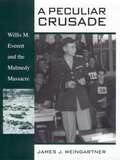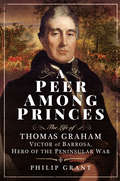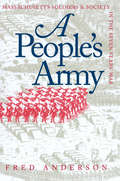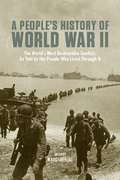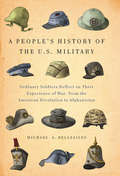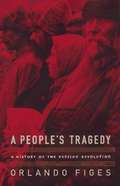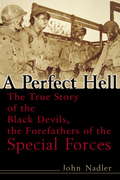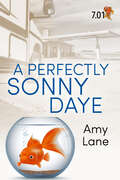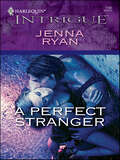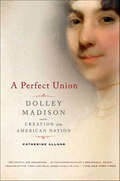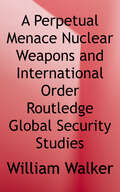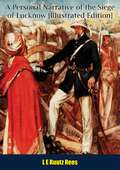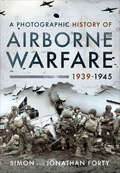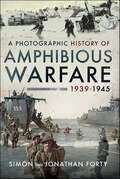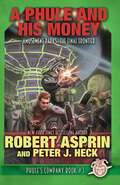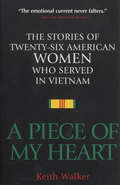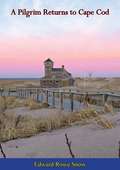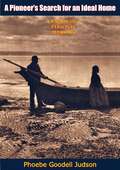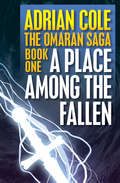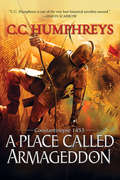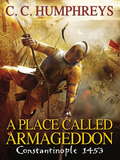- Table View
- List View
A Peculiar Crusade: Willis M. Everett and the Malmedy Massacre
by James J. WeingartnerFresh insights into the infamous Malmedy Massacre—a Nazi war-crime targeting American POWsIn the wake of World War II, 74 members of the Nazi SS were accused of a war crime—soon to be known as the Malmedy Massacre—in which a large number of American prisoners of war were murdered during the Battle of the Bulge. All of the German defendants were found guilty and more than half were sentenced to death.Yet none was executed and, a decade later, all had been released from prison. This outcome resulted primarily from the dogged efforts of Willis M. Everett, Jr., a prominent Atlanta attorney who jeopardized his status as a member of the social elite to defend with great zeal and commitment the accused Germans.James Weingartner offers fresh insights into one of the most controversial episodes of World War II and in the process casts new light on the often convoluted politics of war crimes justice.
A Peer Among Princes: The Life of Thomas Graham, Victor of Barrosa, Hero of the Peninsular War
by Philip GrantThis authoritative biography chronicles the life and achievements of the Victorian era politician and hero of the Napoleonic Wars. Sir Thomas Graham, Lord Lynedoch, is best known for his exceptional military career during the Napoleonic Wars. In the struggle for the Iberian Peninsula, he won a major victory at the Battle of Barrosa, conducted the siege of San Sebastian, and acted as the Duke of Wellington&’s second in command. But Graham was much more than a soldier. An innovative Scottish landowner, politician, sportsman, and traveler, he was a remarkable man of his age. In A Peer Among Princes, Philip Grant does justice to his life and reputation. Lord Lynedoch only took up his military career in 1792 when he was outraged by the violation of his wife&’s coffin by French revolutionaries. Determined to fight them, he raised his own regiment and soon establishing himself as an outstanding leader and field commander. He saw action at Toulon, made a daring escape from the siege of Mantua, served in Malta and Egypt and with Sir John Moore during the Corunna campaign. With quotes from Graham&’s vivid letters and diaries, Grant weaves an absorbing and detailed narrative of his long and varied life.
A People's Army
by Fred AndersonA People's Army documents the many distinctions between British regulars and Massachusetts provincial troops during the Seven Years' War. Originally published by UNC Press in 1984, the book was the first investigation of colonial military life to give equal attention to official records and to the diaries and other writings of the common soldier. The provincials' own accounts of their experiences in the campaign amplify statistical profiles that define the men, both as civilians and as soldiers. These writings reveal in intimate detail their misadventures, the drudgery of soldiering, the imminence of death, and the providential world view that helped reconcile them to their condition and to the war.
A People's History of World War II
by Marc FavreauThe most destructive war in human history, World War II continues to generate an astonishingly rich trove of historical material, writings, and first-person recollections, which are essential to any appreciation of this most pivotal of historical events. A People's History of World War II brings the full range of human experience during World War II to life through some of the most vivid accounts and images available anywhere. This concise and accessible volume includes first-person interviews by Studs Terkel; rare archival photographs from the Office of War Information collection; propaganda comics from Theodore Geisel (Dr. Seuss); narratives of wartime experiences from writers including historian Howard Zinn, civil rights activist Robert L. Carter, and celebrated French author Marguerite Duras; and selections from the writings of some of the world's leading historians of the war, including John Dower, Philippe Burrin, David Wyman, and Eric Hobsbawm.
A People's History of the Civil War: Struggles for the Meaning of Freedom
by David WilliamsDirectly inspired by the approach to history demonstrated by Howard Zinn in the popular A People's History of the United States, Williams (history, Valdosta State U.) explores the role of "common folk" in shaping the Civil War and the many civil wars of social and economic cleavage and conflict that existed during the wider conflict. He describes class conflict along the battlefront, efforts of African-American slaves and freedmen to make the Civil War serve their need for emancipation and equality, Native American reactions to the war, and women's experiences and social struggles. Annotation ©2006 Book News, Inc., Portland, OR (booknews.com)
A People's History of the U.S. Military
by Michael A. BellesilesIn A People's History of the U.S. Military, historian Michael A. Bellesiles draws from three centuries of soldiers' personal encounters with combat-through fascinating excerpts from letters, diaries, and memoirs, as well as audio recordings, film, and blogs-to capture the essence of the American military experience firsthand, from the American Revolution to the wars in Iraq and Afghanistan.Military service can shatter and give meaning to lives; it is rarely a neutral encounter, and has contributed to a rich outpouring of personal testimony from the men and women who have literally placed their lives on the line. The often dramatic and always richly textured first-person accounts collected in this book cover a wide range of perspectives, from ardent patriots to disillusioned cynics; barely literate farm boys to urbane college graduates; scions of founding families to recent immigrants, enthusiasts, and dissenters; women disguising themselves as men in order to serve their country to African Americans fighting for their freedom through military service.A work of great relevance and immediacy-as the nation grapples with the return of thousands of men and women from active military duty-A People's History of the U.S. Military will become a major new touchstone for our understanding of American military service.
A People's Tragedy: A History of the Russian Revolution
by Orlando FigesA comprehensive, one-volume account of the Russian Revolution. Covers every moment, from the end of the nineteenth century to the death of Lenin, and explores how Russian pre-revolution social forces were violently erased and replaced.
A Perfect Explanation
by Eleanor AnstrutherFinalist for the Desmond Elliott PrizeA &“superb debut&”* novel—based on the story of the author&’s grandmother—following an aristocratic woman who abandons her family and her money in search of a life she can claim as her own. (*The Guardian) Enid Campbell, granddaughter of a duke, grew up surrounded by servants, wanting for nothing except love. But when her brother died in the First World War, a new heir was needed, and it was up to Enid to provide it. A troubled marriage and three children soon followed. Broken by postpartum depression, overwhelmed by motherhood and a loveless marriage, Enid made the shocking decision to abandon her family, thereby starting a chain of events—a kidnap, a court case, and selling her son to her sister for £500—that reverberated through the generations. Interweaving one significant day in 1964, when it seems the family will reunite for one last time, with a decade during the interwar period, A Perfect Explanation explores the perils of aristocratic privilege, where inheritance is everything and happiness is hard won.
A Perfect Hell: The True Story of the Black Devils, the Forefathers of the Special Forces
by John NadlerIt's 1942 and Hitler's armies stand astride Europe like a colossus. Germany is winning on every front. This is the story of how one of the world's first commando units, put together for the invasion of Norway, helped turn the tide in Italy.1942. When the British generals recommend an audacious plan to parachute a small elite commando unit into Norway in a bid to put Nazi Germany on the defensive, Winston Churchill is intrigued. But Britain, fighting for its life, can't spare the manpower to participate. So William Lyon MacKenzie King is contacted and asked to commit Canadian troops to the bold plan. King, determined to join Roosevelt and Churchill as an equal leader in the Allied war effort, agrees.One of the world's first commando units, the First Special Service Force, or FSSF, is assembled from hand-picked soldiers from Canadian and American regiments. Any troops sent into Norway will have to be rugged, self-sufficient, brave, and weather-hardened. Canada has such men in ample supply.The all-volunteer FSSF comprises outdoorsmen -- trappers, rangers, prospectors, miners, loggers. Assembled at an isolated base in Helena, Montana, and given only five months to train before the invasion, they are schooled in parachuting, mountain climbing, cross-country skiing, and cold-weather survival. They are taught how to handle explosives, how to operate nearly every field weapon in the American and German arsenals, and how to kill with their bare hands.After the Norway plan is scrapped, the FSSF is dispatched to Italy and given its first test -- to seize a key German mountain-top position which had repelled the brunt of the Allied armies for over a month. In a reprise of the audacity and careful planning that won Vimy Ridge for the Canadians in WWI, the FSSF takes the twin peaks Monte la Difensa and Monte la Remetanea by storming the supposedly unscalable rock face at the rear of the German position, and opens the way through the mountains.Later, the FSSF will hold one-quarter of the Anzio beachhead against a vastly superior German force for ninety-nine days; a force of only 1,200 commandos does the work of a full division of over 17,000 troops. Though badly outnumbered, the FSSF takes the fight to the Germans, sending nighttime patrols behind enemy lines and taking prisoners. It is here that they come to be known among the dispirited Germans as Schwartzer Teufel ("Black Devils") for their black camouflage face-paint and their terrifying tactic of appearing out of the darkness.John Nadler vividly captures the savagery of the Italian campaign, fought as it was at close quarters and with desperate resolve, and the deeply human experiences of the individual men called upon to fight it. Based on extensive archival research and interviews with veterans, A Perfect Hell is an important contribution to Canadian military history and an indispensable account of the lives and battlefield exploits of the men who turned the tide of the Second World War.
A Perfect Sonny Daye: A Fish Out of Water Short Story (Fish Out of Water)
by Amy LaneSonny Daye works hard in the business he and his lover Ace have built from scratch. He sweats through days that shouldn&’t be so hot, he fixes cars that shouldn&’t be broke—he even puts up with customers that oughta just drive off the road and spare the car and Sonny himself the pain. On an ordinary day, Sonny can help a bunch of stupid kids, teach a snotty rich guy a lesson, and stop a felon in his tracks without killing him! It's hard work indeed—but Sonny&’ll do anything for Ace.
A Perfect Stranger
by Jenna RyanP.I. Damon Marlowe always found his man—or, in this case, his woman. Tracking down Darcy Nolan at his client's request was a piece of cake for the ex-cop. But there was something about this assignment that didn't sit right with him. When the attractive blonde was attacked, put into danger by his unwitting exposure, Marlowe told himself he had no choice but to fl ush out her would-be killer. After all, he had compromised the cover of a protected witness to a crime.But was it the guilt that drove him…or a deeper emotion he'd long since buried? Try as he might, Darcy roused feelings he'd rather deny. But for Marlowe, the motive didn't matter. The killer was making his move, and now Darcy was his to protect….
A Perfect Union: Dolley Madison and the Creation of the American Nation
by Catherine AllgorAn extraordinary American comes to life in this vivid, groundbreaking portrait of the early days of the republic—and the birth of modern politicsWhen the roar of the Revolution had finally died down, a new generation of American politicians was summoned to the Potomac to assemble the nation's newly minted capital. Into that unsteady atmosphere, which would soon enough erupt into another conflict with Britain in 1812, Dolley Madison arrived, alongside her husband, James. Within a few years, she had mastered both the social and political intricacies of the city, and by her death in 1849 was the most celebrated person in Washington. And yet, to most Americans, she's best known for saving a portrait from the burning White House, or as the namesake for a line of ice cream. Why did her contemporaries give so much adulation to a lady so little known today? In A Perfect Union, Catherine Allgor reveals that while Dolley's gender prevented her from openly playing politics, those very constraints of womanhood allowed her to construct an American democratic ruling style, and to achieve her husband's political goals. And the way that she did so—by emphasizing cooperation over coercion, building bridges instead of bunkers—has left us with not only an important story about our past but a model for a modern form of politics. Introducing a major new American historian, A Perfect Union is both an illuminating portrait of an unsung founder of our democracy, and a vivid account of a little-explored time in our history.
A Perpetual Menace: Nuclear Weapons and International Order (Routledge Global Security Studies)
by William WalkerWritten by a leading scholar in the field of nuclear weapons and international relations, this book examines 'the problem of order' arising from the existence of weapons of mass destruction. <p><p>This central problem of international order has its origins in the nineteenth century, when industrialization and the emergence of new sciences, technologies and administrative capabilities greatly expanded states' abilities to inflict injury, ushering in the era of total war. It became acute in the mid-twentieth century, with the invention of the atomic bomb and the pre-eminent role ascribed to nuclear weapons during the Cold War. <p><p>It became more complex after the end of the Cold War, as power structures shifted, new insecurities emerged, prior ordering strategies were called into question, and as technologies relevant to weapons of mass destruction became more accessible to non-state actors as well as states. <p><p>William Walker explores how this problem is conceived by influential actors, how they have tried to fashion solutions in the face of many predicaments, and why those solutions have been deemed effective and ineffective, legitimate and illegitimate, in various times and contexts.
A Personal Narrative of the Siege of Lucknow [Illustrated Edition]
by L E Ruutz Rees[Illustrated with over one hundred maps, photos and portraits, of the battles, individuals and places involved in the Indian Mutiny]Fascinating account of Calcutta businessman and merchant L.E. Ruutz Rees of the tumultuous events of the Sepoy Revolt that threatened to overturn British power in India. At time of the rebellion he was travelling toward Oudh, which was to be a hotbed of violence in the coming months, and arrived at Lucknow. Initially confident that a complete uprising was not likely, Rees joined the irregular cavalry under General Lawrence when it was clear that significant fighting was imminent. He recounts the ill-conceived and badly managed attempt by Lawrence to breakout of Lucknow and following the botched battle of Chinnut he was forced back to Lucknow and the bitter fighting of the siege. Rees recounts the difficulties, heroics, brutalities and hard fighting of the siege within the 33 acre Residency site that lasted 88 days until the first relief. The final deliverance only arrived many days and much hardship later with the appearance of Sir Colin Campbell’s force as the second relief of Lucknow.
A Photographic History of Airborne Warfare, 1939–1945
by Simon Forty Jonathan FortyOn 10 May 1940 German Fallschirmjäger stormed the Dutch fort of Eben-Emael, south of Maastricht. The brilliantly executed operation was the first signal success by airborne troops in the Second World War and it made the military world sit up and take notice. Improved parachutes and the creation of gliders that could carry troops meant that assault forces could be dropped or landed behind enemy lines. This was a significant new tactic which had a dramatic impact on several of the key campaigns, and it is the subject of Simon and Jonathan Forty’s in-depth, highly illustrated history. They tell the story of the development of airborne forces, how they were trained and equipped, and how they were landed and put into action in every theatre of the global conflict. The results were mixed. German airborne forces were victorious on Crete, but the cost was so great that Hitler vowed never to use them in the same way again. The Allies saw things differently. After Crete they built up elite units who would play important roles in later battles – in Normandy, for example, where the British 6th Airborne Division took vital bridges prior to the D-Day landings. These are just two examples of the many similar operations on the Western and Eastern Fronts and in the Pacific which are covered in this wide-ranging book. It offers the reader a fascinating insight into airborne warfare over seventy years ago.
A Photographic History of Amphibious Warfare 1939–1945
by Simon Forty Jonathan Forty"...contains a plethora of after-action reports, diagrams and text which makes the work a thorough and engaging study of amphibious landings during the war." —WWII History MagazineAmphibious operations have always been an important element of warfare, but they reached their climax during the Second World War when they were carried out on a large scale in every theater of the conflict. That is why this wide-ranging, highly illustrated history of amphibious warfare 1939–1945 by Simon and Jonathan Forty is of such value. Their book gives graphic accounts of the main amphibious assaults launched by the major combatants, in particular the British, American, German and Japanese – not just large-scale landings like those in North Africa, Normandy, the Philippines and Okinawa, but also raids such as Dieppe and St Nazaire and evacuations like Dunkirk and Kerch. The rapid development of amphibious tactics and equipment is an essential element of the story, as are the vital roles played by the navies, air forces, armies and special forces in each complex combined operation. There is also a section on amphibious operations that were planned but didn’t happen, such as the German invasion of Britain and the Italian and German operation against Malta.
A Phule and His Money: Amusement Parks—The Final Frontier (Phule's Company)
by Peter J. Heck Robert AsprinFrom a New York Times bestseller, a commander leads a legion of misfits as they create an amusement park on another planet in this sci-fi comedy. Captain Willard Phule has whipped his troops into shape, turning Phule&’s Company from the laughingstock of the Legion into . . . a crack team of casino security guards. Now his company is deployed to help an underdeveloped planet. And what better way to utilize their major area of expertise—goofing off—than to turn the planet into the biggest intergalactic playground ever? Praise for the Phule&’s Company series: &“A winning story . . . part science fiction, part spoof, part heart-warmer.&” —Publishers Weekly &“Madcap . . . a welcome sendup of military sf.&” —Booklist &“Light without being frivolous, and displays Asprin&’s considerable expertise about fencing and things military, especially leadership.&” —Chicago Sun-Times &“Reminiscent of &‘M*A*S*H.&’&” —Analog Science Fiction and Fact Magazine
A Picturesque Tour Of The Island Of Jamaica: From Drawings Made In The Years 1820 And 1821 (1825)
by James HakewillHaving published his Picturesque Tour of Italy in 1820, Hakewill visited Jamaica in 1820-21, making the colony the subject of a wonderful color plate book, originally issued in 7 parts from 1824 through 1825. The lithographs are engraved by Sutherland (6) and Clarke after drawings by Hakewill. The views comprise: The Bog Walk, Cardiff Hall, Port Marial Waterfall of the Windward Road, Trinity Estate, Bryan Castle, Great House, Trelawny, and Williamsfield Estate.-Print ed.
A Piece of My Heart: The Stories of 26 American Women Who Served in Vietnam
by Keith WalkerA decade after America pulled out of Vietnam, the seeds of the often heart- wrenching oral history, A Piece of My Heart, were sown when writer and filmmaker Keith Walker met a woman who had been an emergency room nurse in Cu Chi and Da Nang. She and 25 others recount the time they spent "in country" as part of 15,000 American women who volunteered or served as nurses and in the military.NOTE: This edition does not include photographs.
A Pilgrim Returns to Cape Cod (Snow Centennial Editions Ser.)
by Edward Rowe SnowA Pilgrim Returns to Cape Cod, which was originally published in 1946, is an engrossing tale that chronicles Edward Rowe Snow’s 235-mile trek through Cape Cod that same year.Owing to its historic, maritime character and ample beaches, Cape Cod, which extends into the Atlantic Ocean from the southeastern corner of mainland Massachusetts in northeastern USA, is a popular tourist attraction particularly during the summer months.Filled with information on the maritime history of this area, with the author’s usual emphasis on the lighthouses, life-saving and shipwrecks, this book provides a wealth of information on the area. A wonderful read!Richly illustrated throughout with photos.
A Pioneer’s Search for an Ideal Home: A Book of Personal Memoirs
by Phoebe Goodell JudsonPhoebe Judson was a young bride in 1853 when she and her husband crossed the plains from Ohio to the Puget Sound area of Washington Territory. She was ninety-five when this book was first published in 1925. The years between were spent in “a pioneer’s search for an ideal home” and in living there, when it was finally found at the head of the Nooksack River, almost on the Canadian border.Phoebe Judson’s account of the journey west is based on daily diary entries detailing her fear, excitement, and exhaustion. At the end of the trail, the Judsons encountered hardships aplenty, causing them to abandon a farm and business in Olympia before their arrival in the Nooksack Valley. During the Indian Wars they holed up in a fort at Claquato. In time, Phoebe overcame her fear of the Indians, learned the Chinook language, and won their friendship. All this is told in vivid detail by a woman of great dignity and charm whom readers will long remember. Susan Armitage, professor of history at Washington State University, calls A Pioneer’s Search for an Ideal Home a “classic pioneering account,” important for its woman’s point of view.
A Place Among the Fallen (Omaran Saga #1)
by Adrian ColeThe &“thrilling&” first novel in the grimdark Omaran Saga. &“Cole creates a dark mystery and sense of dread that pulls the reader in&” (Fantasy Literature). Omara's people shun all belief in the power of gods and magic, and the Deliverers, led by Simon Wargallow, pledge to put to death all heretics. When Korbillian flees his magical land of Ternannoc in the midst of a catastrophic destruction, he takes refuge on Omara and begins a quest to save this planet from its inevitable fate--the same as that of Ternannoc. Battles erupt in the clashes between destruction and salvation, from the fishing village of Sundhaven to the plateau of Xennidhum. Death becomes life for the people, and life is on its way toward death. Don't miss the entire quartet, including THRONE OF FOOLS, THE KING OF LIGHT AND SHADOWS, and THE GODS IN ANGER
A Place Called Armageddon: Constantinople 1453
by C.C. Humphreys"C.C. Humphreys is one of the very best historical novelists around." —Simon Scarrow, bestselling author of the EAGLES OF THE EMPIRE seriesPerfect for fans of Bernard Cornwell, A Place Called Armageddon is an epic tale of one of history's greatest battles for one of the world's most extraordinary places. Gregoras had vowed never to return to Constantinople, the cursed home that had betrayed and scarred not only his mind, but his face, for all to see. But now with 100,000 Muslim soldiers outside its walls, he can hear its desperate calls for his help, as it can only be held by men and mercenaries as skilled in battle as Gregoras, of which few remain. His return home, though, will mean not only having to face the constant hum of arrow and cannon, but also Theon, twin brother...and betrayer. And with him his beloved Sofia, lost when Gregoras was cast from his home, now bound to Theon in marriage. But the rewards of victory would not only be the glories of the battle, but the redemption of his name and his soul.
A Place Called Armageddon: The epic battle of Constantinople, 1453
by Chris Humphreys'A great tale, finely woven with action, palpably real characters and terrific twists of fate' Simon Scarrow'Bernard Cornwell is good, but Humphreys is better' Historical Novels ReviewAn epic new novel about one of Western civilisation's most traumatic events - the Fall of Constantinople...Constantinople. For a thousand years, the city was the heart of the vast Byzantine empire. Beloved of Greeks. Coveted by Turks.1453. The empire has shrunk to what lies within its no-longer magnificent walls. Yet for one man, Constantinople is the stepping stone to destiny. Mehmet 11, just twenty when he is anointed Sultan, brings an army of one hundred thousand, outnumbering the defenders ten to one, and the most deadly threat the city has ever faced - the largest cannon in the world. But a city is more than stone, its fate inseparable from its citizens'. Like Gregoras, mercenary and exile, returning to the hated place he once loved. Theon, his twin - and betrayer. Sofia, loved by two brothers, forced to choose between them. And Leilah, mystic and assassin, seeking her own destiny in the flames...
A Place Called Armageddon: The epic battle of Constantinople, 1453
by Chris Humphreys'A great tale, finely woven with action, palpably real characters and terrific twists of fate' Simon Scarrow'Bernard Cornwell is good, but Humphreys is better' Historical Novels ReviewAn epic new novel about one of Western civilisation's most traumatic events - the Fall of Constantinople...Constantinople. For a thousand years, the city was the heart of the vast Byzantine empire. Beloved of Greeks. Coveted by Turks.1453. The empire has shrunk to what lies within its no-longer magnificent walls. Yet for one man, Constantinople is the stepping stone to destiny. Mehmet 11, just twenty when he is anointed Sultan, brings an army of one hundred thousand, outnumbering the defenders ten to one, and the most deadly threat the city has ever faced - the largest cannon in the world. But a city is more than stone, its fate inseparable from its citizens'. Like Gregoras, mercenary and exile, returning to the hated place he once loved. Theon, his twin - and betrayer. Sofia, loved by two brothers, forced to choose between them. And Leilah, mystic and assassin, seeking her own destiny in the flames...
